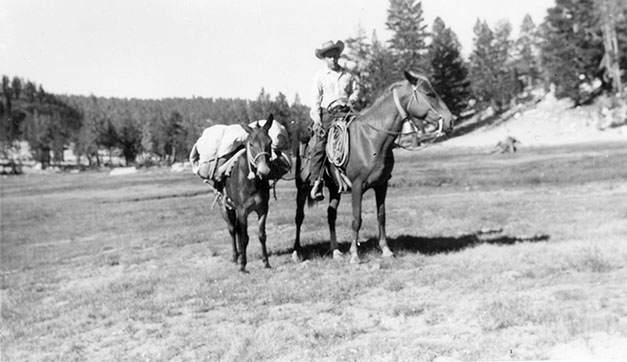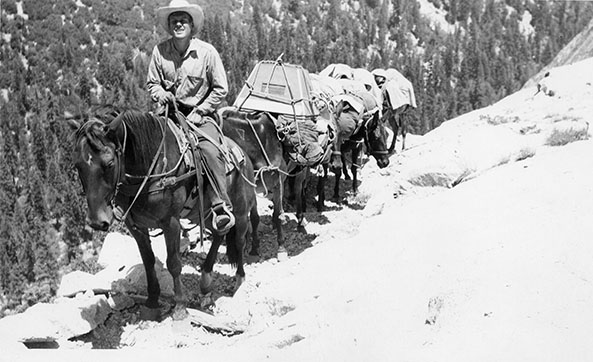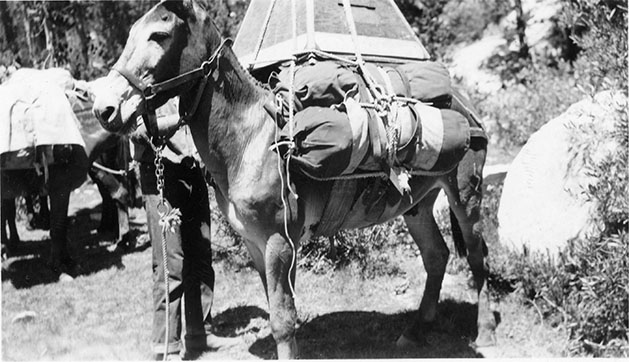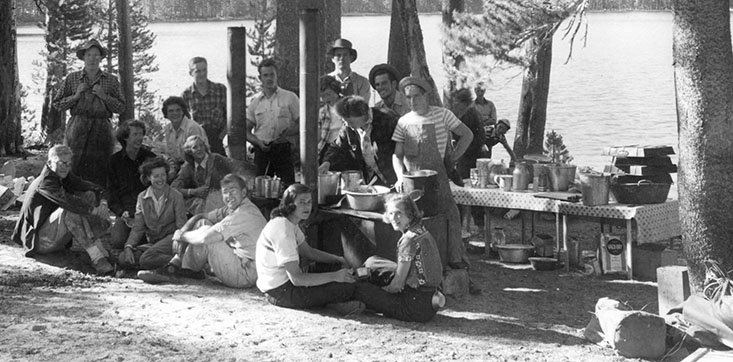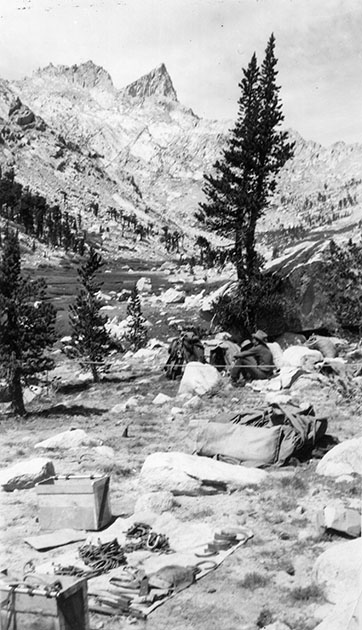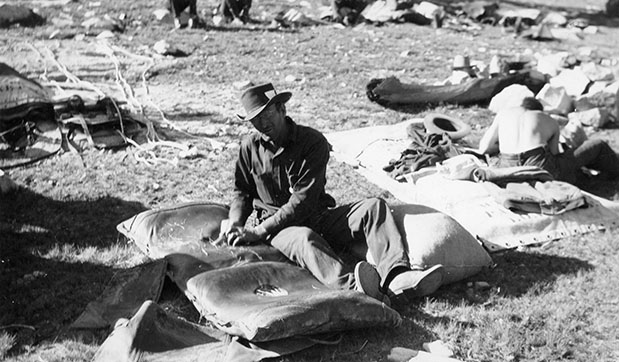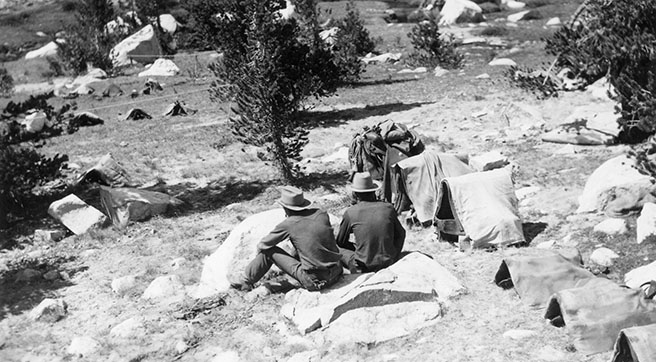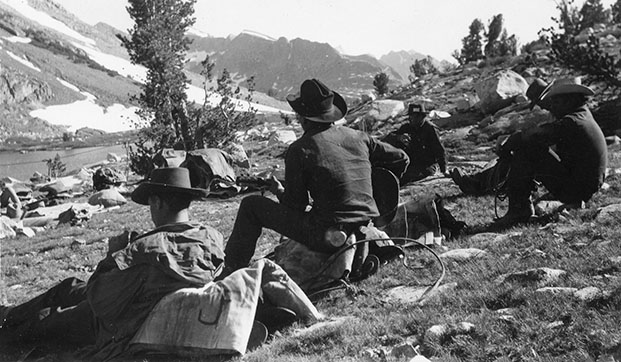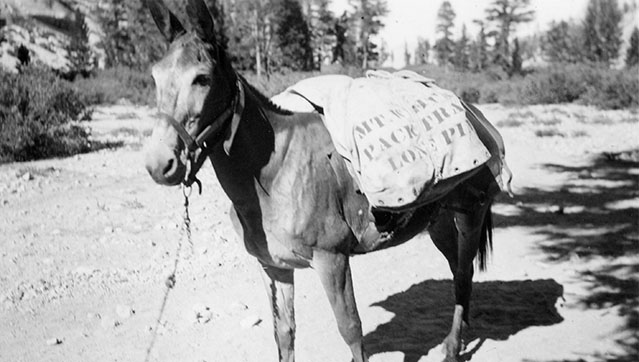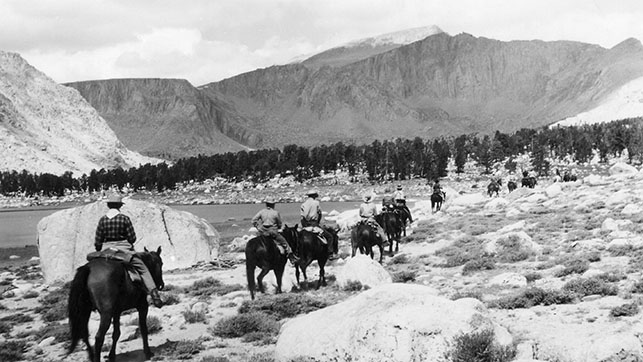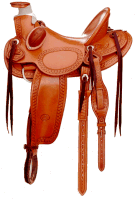 |
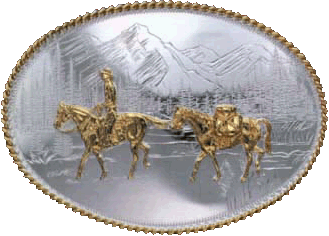 Mt. Whitney Packers of the 1940s - 1950s |
|
See USE NOTICE on Home Page |

|
|
What, only one mule! The packers
life is, without a doubt, one of the best there is. It is too
bad that here in the west that that life is confined to the summer.
When winter sets in, so does the snow and everyone goes back
to some "fall back" job - school for the students and
saddlery or something else for the non-students. It seems that
no matter what the job at the pack outfit it is always exciting;
and, something which you yearn to do. It might be the toughest
job that you've ever done in your life - shoeing stock, wrangling,
packing up camp, loose herding stock or driving stock trucks
- but for some strange romantic reason seldom does a packer not
wish to return the following summer. |
by Blanche Stallings
Charley Gilmore on the trail. Somewhere in the backcountry Charley Gilmore seems to be having quite a time. What the heck is that load on your first mule Charley? From lumber to hay, 225 pound stoves to every conceivable configuration of pot and pan, dunnage to dynamite and sides of beef to fresh watermelons and cantaloupes; anything that could be packed, the packer would find a resourceful way to not only get on his mule but somehow get the load balanced and tied down with that famous Mt. Whitney Packers diamond hitch. Let's not forget that a well tied down load in the morning is no guarantee that it will last the entire day! The "best tie loads of mice and packers" often loosened up with the heat of the mule and the day. It always paid to check those loads throughout the day. I remember once, while pushing stock 15 miles from the mountain corrals of Whitney Portals down to the desert corrals of the Elder Ranch, I neglected to cinch up the saddle on my horse sufficiently and about one mile down the road, after the horse had worked up a sufficient sweat, off slipped the saddle and me! What an utterly embarrassing moment! By the time I caught my horse and got resaddled the other packers and stock were a half mile ahead of me and Irene, Tommy and Barbara got the laugh of the morning! |
Sierra
Club "High Trip" Commissary The Club commissary seemed to always be the focal point for exciting conversation, social happenings, and an opportunity to "get on the good side" of both the cooks and the commissary girls. Those cooks were always the best! Was it all of the fresh food they had to work with, the aura of the Sierra Nevada or the adventurous people they "catered" to? Whatever it was, it always kept you coming back for more. I recall one high trip trip when Bob Golden was cook. We were camped in Lower Rock Creek and Bob was cooking up some fantastic steaks. One of the packers, Ed Brown, told him to throw a steak on the stove for him and make sure it was well done. Ed didn't come back to get that steak for about 45 minutes! I swear, Ed must have just been eating a piece of charcoal. |
|
L
to R: Need
some help from you Club members to identify these folks! |
|
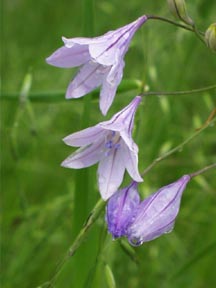 |
 Stephen H. Willard "Photocard" (from archives of Bill Smart) [Stephen Willard bio.] |
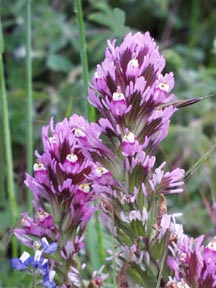 |
Located just
south of Garnet and Nydiver Lakes, with the Minarets to the southwest
and Mt. Ritter and Banner Peak to the northwest is majestic Ediza
Lake. Fed by the overflow from Celie and Iceberg Lakes, Ediza
Lake gives rise to Shadow Creek at its terminus. To the east
are Deadman Pass and Agnew Passes. The Minarets, as seen in this
picture of Ediza Lake, are the presumed burial place of famed
mountaineer, trail blazer, and Sierra Club advocate - Walter A. Starr, Jr. |
||
by David Brower
Cottonwood Lakes and Mt. Langley |
| The
Trail Riders of the Wilderness heading by one of our favorite
spots in the Mt. Whitney region, the Cottonwood Lakes at the
foot of Mt. Langley. Before the Horseshoe Meadows road was blasted
in the eastern face of the Sierra Nevada, beginning at the old
Carroll Creek packstation, these lakes were some of the finest Golden Trout fishing in the Sierra Nevada.
Once the road was in, along came the poachers and all but the
rock-rimmed upper lakes were closed to fishing. These are the
breeding grounds were nearly all of the Golden Trout eggs are
harvested for later hatching and fingerling replanting throughout
the rest of the Sierra. In spite of the poachers, litterers,
and city slickers that burned down the old Cottonwood Sawmill
which had been part of Owens Valley history for nearly 100 years
this is still a magnificent area to visit. Of course if I had
my way, I would have the road closed and dynamited and the pack
stations restored at Carroll and Cottonwood Creeks at the base
of the mountains. Somehow a grueling, waterless, 15 mile hike
from the desert floor to Big and Little Cottonwood Creeks deterred
nearly all vandals from the region |
|
|
1995 Mt. Whitney Packer's Reunion | |
|
|
Packing & High Sierra Stories | |
|
More Mt. Whitney Packers of the 1940s and 1950s |
|
|
|
Wildflowers of the Sierra Nevada |
|
|
|
One Packers High Sierra Experience |
|
Sign Guestbook View Old Guest Book Entries Oct 1999 - Feb 2015 (MS Word) |
 CONTACT the Pigmy Packer |
View Guestbook View Old Guest Book Entries Oct 1999 - Feb 2015 (PDF) |

